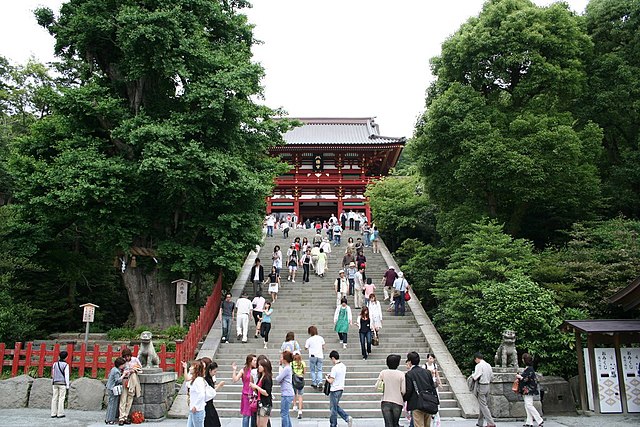Minamoto no Sanetomo was the third shōgun of the Kamakura shogunate. He was the second son of the Kamakura shogunate founder, Minamoto no Yoritomo. His mother was Hōjō Masako and his older brother was the second Kamakura shogun Minamoto no Yoriie.
Painting of Minamoto no Sanetomo by Yashima Gakutei. Edo period circa 1825.
Sanetomo in court clothing, painting by the priest Goshin.
Grand stairway at Tsurugaoka Hachiman-gū in Kamakura – the scene of Sanetomo's assassination
Shinto symbolism encompasses the girth of the ancient ginkgo tree at the foot of the stairs leading to the upper level of Kamakura's great Hachiman Shrine. The tree, near the spot where Sanetomo was ambushed and killed, was blown down on 10 March 2010.
Shogun, officially sei-i taishōgun , was the title of the military rulers of Japan during most of the period spanning from 1185 to 1868. Nominally appointed by the Emperor, shoguns were usually the de facto rulers of the country. Although during part of the Kamakura period and Sengoku period, shoguns were figureheads themselves, with real power in the hands of the shikken (執権) of the Hōjō clan and kanrei (管領) of the Hosokawa clan. In addition, Taira no Kiyomori and Toyotomi Hideyoshi were leaders of the warrior class who did not hold the position of shogun, the highest office of the warrior class, yet gained the positions of daijō-daijin and kampaku , the highest offices of the aristocratic class. As such, they ran their governments as its de facto rulers.
Sakanoue no Tamuramaro (758–811) was one of the first shoguns of the early Heian period.
Taira no Masakado's rebellion is historically significant as the first rebellion of the warrior class and the first attempt of the warrior class to establish a government.
Minamoto no Yoritomo, the first shogun (1192–1199) of the Kamakura shogunate
Hōjō Tokimasa shifted the source of power in the shogunate from the shogun to the shogun's assistant, shikken, and established the rule of the Hōjō clan.








